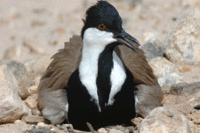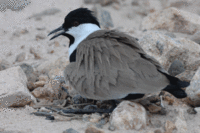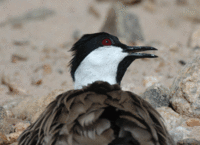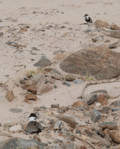30th October 2007
 Tuesday, November 20, 2007 at 08:31PM
Tuesday, November 20, 2007 at 08:31PM It was a grey morning again today. Nonetheless the weavers were back in force at the bird table – a whole crowd of them turned up while we were having breakfast. I wonder how long it will take for the rest of the birds, like the bulbuls and the starlings who are normally so sharp-eyed – to see the good thing the weavers have discovered. As you know, we did see a Grey Headed Sparrow on the bird table yesterday too, so I’m sure it won’t be long before we have a wide selection of feathered friends visiting our balcony.
I’m back in my office now (where there was a pretty moth on the floor), and it’s obvious we’re going to have to put some wire mesh on the windows, as birds keep flying into the office, and then crashing against the glass windows until they find an open one as they try to get out again.
I’ve been taking a few unusual photographs recently, for a series I call “Nature’s Textures” – close-ups of rocks, water, clouds, wood…
I also notice that the lawn grass – a robust variety, of which we “permanently borrowed” a few shoots from one of our neighbours – is starting to perk up. The river grass we planted earlier is doing really well. This is all art of the grass nursery I am fostering, so that we can eventually grass over the Hippo Lawn with star grass and other species which the buffalo and hippo like to munch, and we can also create a more conventional style lawn closer to the house – though with the mixture of grasses we have, and all the different types of plants that self-seed, we’ll actually never be in danger of having a completely conventional lawn!
I went back to the Spur-winged Plover nest again just after midday. It was baking hot and the bird sitting on the nest was obviously doing all it could to stay cool itself and prevent its two precious eggs from overheating. Plovers do this thing called “gular flapping” to cool themselves, opening and closing their throat cavity at fast intervals – apparently it uses less energy than panting - while fluffing out their feathers to allow maximum ventilation. At intervals, the adult would raise its body about an inch above the nests, and sit in that position for a while, as if to allow the through-breeze to cool the eggs. After a while, the other adult approached, and exchanged places with the sitting bird – I could almost feel its relief to be given a break from that relentless sun. The eggs must be hatching any day now – it’ll be interesting to see whether we are able to see the chicks, once that happens. Newly hatched, they will resemble minute little bundles of mottled brown fluff.
While I was at the plovers’ nest, I also took some photos of the Pied Kingfisher which was fishing nearby, hovering above the water in one place, peering down into the water, in search of an unsuspecting meal.
The Baobab tree high on the other bank of the river looked so luminescent in the sun, I couldn’t resist snapping a quick shot of it too, and the reeds which are flowering in the middle of the river. Kyalo, one of the Wakamba guys who works for us, says the fact the Baobab trees are already bearing fruit is not a good sign, in terms of the rains…so perhaps that one downpour and few days of drizzle is all we’re going to get? There has been not a drop of rain for two days now. The river, although it is up a couple of inches on this time last week, is still at a very low level – not a raging torrent as it should be at this time of year.
I saw a big male Kudu on my way back home today – up on the rise behind the house. He was nervous and ran from the car, but it’s great to see him here – bit by bit, he’ll become more accustomed to our comings and goings, and hopefully soon he may even venture down to browse on the vegetation bordering our Hippo Lawn (To Be). The large Monitor Lizard that we’ve been seeing down on the beach over the past few days was right up at the house today…no doubt he’ll find one of the rain drains a comfortable place in which to sleep. Day by day, more and more wildlife moves in, and starts to accept the house as “just part of the furniture”.
We saw a Squacco Heron in full breeding regalia – golden buff on top, with white belly, and impressive plumes on his head and back. He was crouched on the dead tree that’s fallen into the river on the far bank (with a chestnut-coloured Paradise Flycatcher flitting around behind him), and it took us a while to work out what kind of bird he was. Now identified, he’s a new one for my list, along with the Flycatcher. As we were watching the heron, a large flock of jet black Long-Tailed Cormorants raced by, heading downstream. We’ve never seen so many in one flock here, but the two juvenile Cormorants who seem to spend their lives perched in the reeds opposite our house, didn’t even turn their heads as the flock flew past. They seemed more enthralled by the resident Grey Headed Kingfisher, with his flashes of iridescent blue.
My shower was star-spangled this evening. With the moon rising later and later, the nights are very dark and the stars are brilliant. Why do the stars always look brighter in the Tropics? Because they are closer? Because there is less ambient light from major cities and highways to lessen their impact? Or is it all merely an optical illusion - a state of mind perhaps? I turned off the lights and just had the candle-lantern burning so that when I looked from the shower out over the river, I could see the great black massif of the Yatta rising into the dark sky, crowned by a thousand twinkling stars. I love them, but I’m no good at stars. Just about the only constellation I recognise is the Southern Cross. I remember as a teenager, when I was at boarding school in England, I used to love seeing the Southern Cross on my return to Kenya at the end of each term, as it meant I was back home in the southern hemisphere again.
The night is hot and quiet, apart from a solitary frog croaking some distance away in the river, and elephants rumbling somewhere over to my right – I can hear them now, trumpeting and moving down to the beach… It’s lovely to know the elephants are around but I hope they don’t come and eat all our newly transplanted little Baobabs…
Follow the entire Plover Story in pictures...









Reader Comments